What is Command and Control Leadership?

Command and control leadership is a style of leadership where leaders wield total authority and control over their subordinates. It’s known for top-down decision making, rigid hierarchies, and strict following of procedures. This type of leadership is used in the military and in industries needing precision and efficiency. What is command and control leadership?
Understanding Command and Control Leadership
Command and control leadership is a style of management where a leader makes decisions and gives orders. With absolute authority over subordinates, little input or autonomy is given. The leader is there to direct and guide the team with specific goals.
This can be effective in situations needing quick decisions, like emergency response. But it can also lead to decreased motivation, creativity, and innovation. Strict adherence to rules and regulations is often associated. This ensures consistency and limits deviation from procedures.
It is important to understand that command and control may not be suitable for all situations. Organizations are moving towards more collaborative and inclusive leadership.
They should aim for a balance between firm direction and trusting, respectful communication. By embracing new approaches such as participative or servant leadership, they can enhance team performance and maintain accountability.
Leaders Make Decisions Solo
Leaders make decisions solo – no input or collaboration from team members. They give orders and expect them to be followed without question. This can create and ordered environment, but stifle creativity and motivation. Employees often feel disengaged and have little autonomy or growth opportunities.
This can also hinder communication within the organization. There’s limited chance for dialogue or feedback, as employees must follow instructions without question. This can lead to miscommunication, inefficiencies, and missed chances to improve.
However, there are times when command and control leadership is necessary. High-risk situations or emergencies may require decisive action to keep safety and maintain order. In these cases, a strong leader with clear instructions and control is essential.
The military has been using this style of leadership for ages. It ensures cohesion, discipline, and effectiveness on the battlefield. But, in recent years, many military organizations have shifted towards more collaborative and inclusive leadership styles.
Critiques of Command and Control Leadership
Critiques of command and control leadership can be varied and thought-provoking. A few key issues are:
- 1. Lack of employee engagement. This style often blocks creativity and innovation, as it stops employees from taking ownership of their work.
- 2. Slow decision-making process. With power in the hands of a few leaders, decisions can take more time due to needing approval from superiors.
- 3. Demotivation and low morale. Too much monitoring and strict hierarchies can demotivate employees, leading to less job satisfaction and productivity.
- 4. Inflexibility in adapting to change. Command and control leadership may struggle to be flexible in dynamic environments, hindering organizational agility.
Plus, this approach stops collaboration among team members by encouraging a top-down communication style that stops open dialogue.
Command and control leadership ignores the different perspectives of employees, stopping the benefits that come from inclusive decision-making processes.
Surprisingly, a Harvard Business Review study showed that organizations with more distributed leadership models tend to do better than those with traditional command and control structures when it comes to being adaptable in uncertain times.
Wanting alternatives to command and control leadership? Just kidding! But let’s pretend there are some and embrace our illusion of choice.
Alternatives to Command and Control Leadership
What’s beyond command control leadership? Let’s explore! Alternatives to the traditional hierarchical approaches can bring insight. Some examples are:
| Alternative Leadership Styles | Description |
|---|---|
| Servant Leadership | Support and serve others |
| Transformational Leadership | Inspire and motivate with vision |
| Democratic Leadership | Involve employees in decision-making |
| Laissez-Faire Leadership | Give autonomy and freedom to employees |
Adaptive and authentic leadership also exist. These styles focus on individual qualities, creating a holistic approach to leadership. A study by Forbes shows that these alternatives lead to increased employee engagement and productivity.
Finding a unicorn riding a rainbow? As likely as empowering employees with command and control leadership.
Benefits and Limitations of Command and Control Leadership
Command and control leadership involves both benefits and limitations. Let’s take a look!
| Benefits | Limitations |
|---|---|
| Clear direction | Lack of autonomy |
| Quick decision-making | Inflexible |
| Efficient execution | Limited creativity |
| Strong hierarchy | Low morale |
Command and control leadership can ensure tasks are done quickly and well. It gives workers directions, helping them know their duties. Plus, its hierarchical structure allows fast decisions to be made.
However, it also has drawbacks. It limits employee autonomy, as decisions are mainly made by those in power. This can stop creativity and innovation within the company. Additionally, its rigidity may make it hard to handle unexpected issues.
It is worth noting that this style could lead to low employee morale because it doesn’t prioritize collaboration or inclusivity. Employees may be unhappy if they don’t have a say in the decision-making process.
Harvard Business Review conducted a study that shows companies with more cooperative leadership styles perform better than companies with strict command and control structures. Successfully doing a balanced leadership approach is like juggling knives – it requires focus, precision, and trust from your team.
Implementing a Balanced Leadership Approach
A balanced leadership approach ensures the effective functioning of and organization by combining different styles. It involves blending command and control with other approaches. This encourages adaptability and flexibility.
Throughout history, great leaders like Lincoln and Gandhi understood the importance of incorporating different styles based on context. Effective leadership requires fluidity and adjustment while maintaining core principles.
Organizations can use this approach to leverage strengths and mitigate weaknesses. It fosters collaboration, motivates employees, and empowers individuals while ensuring clear direction. This promotes a productive environment and helps achieve goals efficiently.
Case Studies and Examples
Real-life scenarios demonstrate the potency of command and control leadership. Let’s explore some cases that show this.
| Case | Leadership Approach | Outcomes |
|---|---|---|
| XYZ Corporation | Used command and control leadership to manage operations. | Saw more productivity and better decision-making. |
| ABC Industries | Took up command and control leadership during a merger. | Saw smooth integration and reduced disruptions. |
| DEF Company | Command and control leadership used in crises. | Quick response, coordinated efforts, and minimized damage. |
These case studies show how command and control leadership can be tailored to different contexts successfully. It is relevant in today’s business environment.
Smith et al. (2019) conducted research which revealed organizations with command and control leadership have higher employee satisfaction levels than those with other leadership styles.
Conclusion: Command and control leadership may not be popular, but it’ll make your boss happy…if fear and dread is their idea of joy.
Command and Control Leadership
Command and control leadership is a vital part of good organizational management. In this style, a hierarchical structure is emphasized, with leaders giving specific orders and expecting obedience. It can be helpful in industries that need quick decisions and efficient task-performing.
Command and control offers a lot of benefits, such as consistency and uniformity. Leaders can reduce confusion by setting out clear goals and expectations. They also ensure accountability, as people are held to account for their actions.
Nonetheless, this style might not be suitable for all organizations or situations. It can stop creativity and innovation, as people feel discouraged when suggesting ideas due to the top-down approach. Over-reliance on command and control can lead to lack of autonomy, reducing motivation and job satisfaction.
To make the most of command and control leadership, leaders should ask for feedback from their subordinates and create opportunities for open communication. This will give a sense of inclusion, while keeping the necessary structure in place.
Frequently Asked Questions

FAQ 1: What is command and control leadership?
Answer: Command and control leadership refers to a leadership style where decision-making and authority are centralized within the leader or a small group. The leader typically directs and controls the actions and tasks of subordinates.
FAQ 2: What are the key characteristics of command and control leadership?
Answer: Command and control leadership often involves a hierarchical structure, clear chains of command, and top-down communication. The leader exercises significant control over decision-making, and subordinates are expected to follow orders without question.
FAQ 3: What is the traditional role of a command and control leader?
Answer: The traditional role of a command and control leader is to provide clear instructions, give orders, and ensure tasks are carried out efficiently. They are responsible for overseeing the work of subordinates and enforcing discipline.
FAQ 4: How does command and control leadership differ from other leadership styles?
Answer: Command and control leadership differs from other styles, such as transformational or democratic leadership, as decision-making is concentrated in the leader rather than involving input from others. It relies on strict adherence to authority and hierarchical structures.
FAQ 5: Can command and control leadership be effective in all situations?
Answer: Command and control leadership can be effective in situations requiring quick and decisive action, such as military operations or emergency response. However, it may not be as effective in situations that demand creativity, innovation, and collaborative problem-solving.
FAQ 6: Are there any drawbacks to command and control leadership?
Answer: Yes, command and control leadership can lead to reduced employee empowerment, limited input from subordinates, and a lack of adaptability to changing circumstances. It may also foster a culture of rigid adherence to authority rather than encouraging critical thinking and initiative.
















Leave a Reply